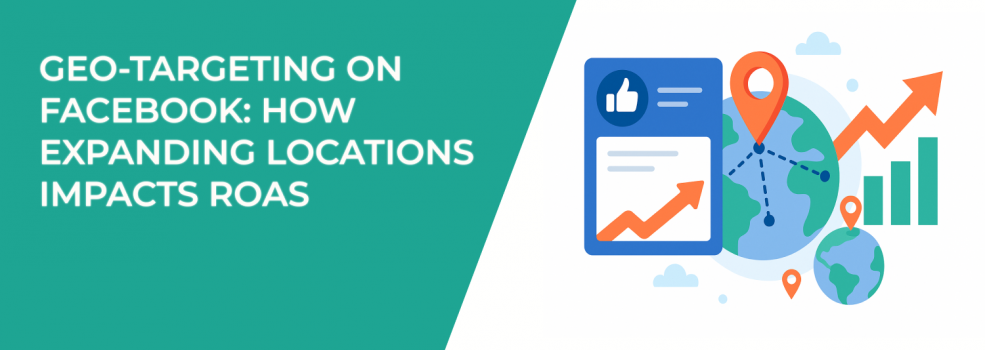Geo-targeting on Facebook is one of the biggest factors that decides whether your ads bring profit or waste money. The places you choose to target affect who sees your ads, how much you pay, and how many sales you get. Expanding your locations can sometimes boost results, but it can also cut your return on ad spend (ROAS) fast if you’re not careful.
So, when does expanding locations work, and when does it hurt your Facebook ads?
Why Geo-Targeting Matters
Facebook lets you show ads by country, city, or even a few kilometers around a spot on the map. That sounds simple, but it changes everything about how your campaigns perform.
For example:
-
A local restaurant should only target a small radius around its address. Reaching people 50 km away won’t bring real customers.
-
A digital product business can target multiple countries at once. An e-book or software has no shipping or delivery barriers, so it makes sense to go wider.
If you’re new to Facebook targeting and want to refine the basics, check out Facebook Ad Targeting 101: How to Reach the Right Audience. It explains the foundations that every advertiser should master before playing with advanced settings like geo-expansion.
How Expanding Locations Affects ROAS
When you broaden your targeting, the changes don’t just show up in reach — they appear in cost and conversions too. Here are the most common effects advertisers see:
-
Cheaper or more expensive clicks. Some countries have less competition, so clicks cost less. Others are crowded, and CPC rises. Lower costs don’t always mean better ROAS.
-
Conversion drop-offs. If new regions face high shipping fees or payment problems, people abandon carts. That kills profit.
-
Weaker audience signals. Facebook learns from user actions. Mixing strong buyers with low-engagement regions confuses the algorithm, making campaigns less effective.
-
Different buyer power. A country where average income is low might click on your ads but not buy your $100 product.
This is why many advertisers panic when they see their ROAS drop after going broad. If you’ve had this issue, you’ll relate to What to Do When Broad Targeting Kills Your ROAS, which dives deeper into this exact problem.
When Expanding Works
Not every expansion is a mistake. In the right context, broader geo-targeting can deliver real growth. Some of the best use cases include:
-
Digital products. SaaS, e-books, or online courses scale well across borders because there’s no shipping. A $10 subscription app can profit in both the US and India.
-
Similar markets. Expanding from the US to Canada, UK, or Australia often works well. The culture and language are close, and purchasing power is similar.
-
Seasonal campaigns. Events like Black Friday or the World Cup can be strong reasons to go broad, since interest spikes globally.
Expansions like these are easier to manage if you understand how Meta Ad Campaign Objectives influence delivery and optimization. The wrong objective in a new region can ruin otherwise good testing.
When Expansion Fails
Still, many advertisers lose money when they go too wide. Expanding geo-targeting usually backfires in situations like these:
-
Physical products with high shipping. Selling a $30 item to a country where shipping costs $25 kills margins.
-
Industries needing trust. Finance, healthcare, or legal services rarely convert outside local areas.
-
Language gaps. Ads in English shown to audiences in Germany or France usually underperform compared to local-language ads.
If your campaigns are delivering impressions but not sales, it may also point to a mismatch in targeting. Facebook Ads Not Converting: How To Fix It offers step-by-step advice on diagnosing why clicks fail to turn into purchases.
Smarter Ways to Expand Geo-Targeting
If you’re ready to test expansion, the best approach is to control risk while gathering useful data. Instead of spreading your budget too thin, try these steps:
-
Run separate campaigns for each region. This makes it easy to compare performance and stop weak markets.
-
Test small budgets first. Spend $20–$50 per day in a new region. Scale only if you see checkouts, not just clicks.
-
Watch checkout data. See where users drop off. Payment failures or shipping fees are often hidden reasons for bad ROAS.
-
Use layered targeting. Combine new locations with interests or lookalike audiences so your ads still reach relevant people.
If you’re struggling to figure out how detailed targeting can work with geo-expansion, How to Use Facebook Detailed Targeting to Reach Micro-Niche Audiences is a great resource. It shows how to refine audiences so even broader regions stay relevant.
Final Thoughts
Expanding geo-targeting on Facebook can grow your reach and even lower your ad costs, but it doesn’t always improve ROAS. For digital products or global niches, going broad often pays off. For physical products with shipping limits or industries that rely on trust, it usually burns budget.
The best way forward is to test carefully, compare regions separately, and cut what doesn’t work. That’s how you keep your ROAS healthy while exploring new opportunities.
So before you hit “add more locations” in Ads Manager, ask yourself: will this expansion bring real buyers, or just more clicks?

